Manassas National Battlefield Park preserves over 5,000 acres of Virginia countryside and is the site of some of the bloodiest fighting in the American Civil War.
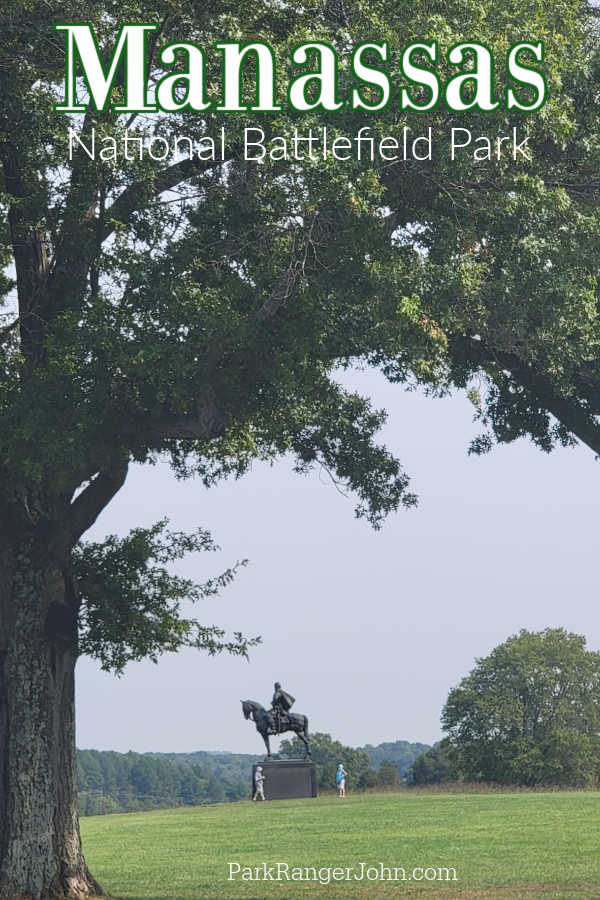
Manassas National Battlefield Park
The first major battle of the Civil War occurred on July 21, 1861, near Bull Run and the important railroad junction at Manassas. It is hard to believe but some residents of Washington DC drove out in their carriages to watch the battle for entertainment.
About Manassas National Battlefield Park
During the first Manassas Battle, the Union Troops gained an early advantage but Confederate reinforcements arrived and turned the battle into a retreat of Union soldiers running back to Washington DC.
During this battle, more than 800 soldiers were killed and more than 2,500 were wounded. This battle made both sides realize that this war was going to last longer than expected and have far more casualties than they expected.
The second battle at Manassas occurred in late August 1862. This battle also ended with a Confederate victory by General Robert E. Lee's Army of Northern Virginia.
One thing to know is this area is known as both Manassas and Bull Run. During the war, Northerners would name battles after rivers or geographical features while Southerners would use names of towns or railroad junctions.
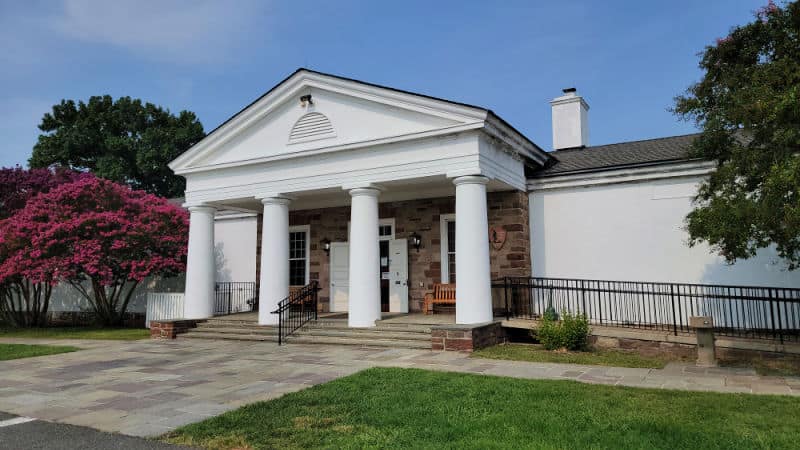
Is Manassas National Battlefield Park worth visiting?
Yes, The site offers the opportunity to see artifacts and learn more about two major battles during the Civil War.
History of Manassas National Battlefield Park
Manassas National Battlefield Park preserves the site of not one but two battles of the American Civil War.
The Manassas National Battlefield Park is where the first major battle of the American Civil War took place on July 21st, 1861. The Second Battle of Manassas took place from the 28th to the 30th of August 1862.
The First Battle of Manassas, or the First Battle of Bull Run, was the first time the Confederate and Union forces engaged in open battle.
The Second Battle of Manassas happened just thirteen months later and was equally important. The Second battle to take place here was a Confederate victory that would lead to the first invasion of the North.
The American Civil War began on April 12th, 1861, when tensions between the Northern and Southern States finally came to a head.
The election of Abraham Lincon in 1860, a staunch abolitionist, was the last straw for the Southern States. The Confederates opened fire on Fort Sumter and, in doing so, began the Civil War.
Seven Southern states had already broken away from the Union when the First Battle of Bull Run began. This first battle showed the North that this war would not be quick or so easily won. The second battle gave the Confederates the confidence to march into the North.
What Caused the Civil War?
The 1800s was a time of rapid growth for the United States. The manufacturing industry in the North of the country was booming.
In the South, cotton and tobacco plantations were flourishing. It was these fundamental economic differences that led to the Civil War.
The prosperous farms of the South relied heavily on slave labor.
By the 1830s many attitudes toward slavery began to shift with the beginning of the Abolitionist Movement.
While radical at the time, these views became more widely accepted, and by 1860 the views of Northern states on slavery were in alignment with those of the abolitionists.
This shift in attitudes was evident by the election of Abraham Lincon.
Abraham Lincon was a member of the newly formed anti-slavery Republican Party.
The Southern states felt that the Republicans and the abolitionists were a threat to their way of life. The abolishment of slavery would severely harm the economy of the Southern states.
The Start of the Civil War
On April 12th, 1861, the Confederate forces under the command of Gen. Pierre G.T Beauregard attacked the Union-held Fort Sumter in Charleston, South Carolina.
For two days the Confederates fired at Fort Sumter, leading to the first Union surrender by Major Robert Anderson.
After the Confederate success at Fort Sumter, four more Southern states left the Union and joined the Confederacy.
Both sides prepared for war during the months between Fort Sumter and the First Battle of Bull Run. The North wanted a quick and decisive strike against the Confederates at their capital of Richmond.
By July 1861, Gen. Beauregard and some 20 000 newly recruited Confederate troops assumed a defensive position at Bull Run Creek.
The Confederates knew that 35 000 Union troops were making their way to the railroad junction at Manassas with the hopes of advancing to Richmond. The two sides skirmished on July 17th at Blackburn's Ford. The fighting was inconclusive and made McDowell reconsider his plan of attack.
The First Battle of Manassas
McDowell's pause to reformulate his plan of attack after the skirmish at Blackburn's Ford gave the Confederates enough time to be reinforced by Johnston and his force of 11 000.
McDowell began his attack on July 21st by shelling the Confederates and attacking their left flank.
Initially, the Union succeeded in pushing the Confederate forces back and up Henry House Hill.
General Jackson, who became known as 'Stonewall' Jackson for his actions, reorganized the Confederate artillery guns and the defensive line on the hill. His actions made sure the Confederates could hold their position.
By the afternoon, the Union was still unable to break the Confederate defensive line on Henry House Hill. The Union forces struggled with uncoordinated attacks and a lack of communication between divisions.
General Beauregard ordered a full assault along the entire Confederate line. It was here that the ‘rebel yell’ was first heard when the Confederates charged the Union forces.
The Confederate assault managed to push the Union back from Henery House Hill and broke through their line.
The First Confederate Victory
Confederate forces succeeded in breaking through the Union's defensive line, leading to the Union's retreat.
The retreat back to Washington was chaotic, with civilians who had been watching the battle nearby joining the frantic Union soldiers.
The Confederate forces did not pursue the retreating Union soldiers, as they were rather disorganized by the end of the Battle of Bull Run.
Both sides made mistakes during this first battle at Manassas. The Union General’s blunders led to his replacement by Gen. George B. McClellan.
The Confederate victory on the battlefield preserved at The Manassas National Battlefield Park gave the Confederates hope that the war would be quick and in their favor. The Northerners, however, grappled with the revelation that the war would not be over within "90 days" as they had hoped.
The Second Battle of Manassas
Thirteen months after the First Battle of Manassas, the Union and Confederates faced each other again on the banks of the River Bull Run in August 1862. Both sides were now more battle-weary after thirteen months of the war.
The Second Battle of Manassas began when Confederate General Robert E. Lee, sent 'Stonewall' Jackson to attack the Union supply base at Manassas. After destroying the supply base, the Confederates hid in the woods and hills.
Jackson surrounded the unsuspecting Union forces commanded by Gen. John Pope, who were advancing to meet the Confederates.
On August 28th, the Union and the Confederates had their first run-in at Brawner Farm, beginning the Second Battle of Bull Run.
On the second day, the Confederates were reinforced with the arrival of Gen. Lee and Gen. Longstreet's divisions.
The Union continued to test the Confederate line with attacks throughout the day. They did make headway, but each time the Confederates pushed them back.
The Second Confederate Victory
The third and final day of the battle saw much of the action centered around Henry Hill and Chinn Ridge. Gen. Pope had received bad intelligence and mistakenly believed that the Confederates were planning to retreat.
Pope, believing the Confederate forces were retreating, ordered an advance on their position. 'Stonewall' Jackson's men, still positioned in the woods, met the Union soldiers as they advanced.
Instead of adjusting his plan of attack, Pope ordered a full assault of the Confederate defensive line. This assault was a mistake.
The Confederates repelled the Union attack with heavy artillery fire, then launched a counterattack. The Union formed a strong defensive line at Henry Hill and managed to hold the line.
After the Battle
At nightfall on August 30th, Pope retreated to Washington, just as the Union General McDowell had done during the First Battle of Manassas.
Retreating from Manassas was not the only thing the two Union Generals would have in common. Pope was relieved of his command of the Army of Virginia after the loss at Bull Run, just like McDowell was.
The second Confederate victory at the site preserved by the Manassas National Battlefield Park boosted Southern Morale. Lee was so confident after his victory in this Second Battle of Manassas that he decided to invade the North.
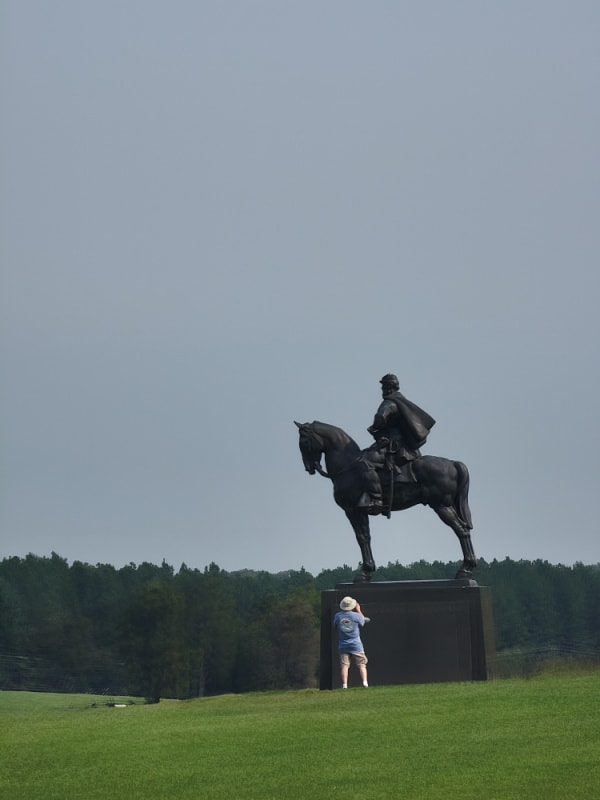
Things to know before your visit to Manassas National Battlefield Park
Entrance fee
$0.00, There is no fee to visit the park
Learn more about National Park Passes for parks that have an entrance fee.
$80.00 - For the America the Beautiful/National Park Pass. The pass covers entrance fees to all US National Park Sites and over 2,000 Federal Recreation Fee Sites for an entire year and covers everyone in the car for per-vehicle sites and up to 4 adults for per-person sites.

Buy your pass at this link, and REI will donate 10% of pass proceeds to the National Forest Foundation, National Park Foundation, and the U.S. Endowment for Forestry & Communities.
National Park Free Entrance Days -Mark your calendars with the five free entrance days the National Park Service offers annually.
Time Zone
Eastern Time Zone
Pets
Pets are permitted on all park trails but must be restrained on a leash no longer than 6 feet.
Cell Service
We had great cell service at the park.
Park Hours
The park is open daily from dawn until dusk.
Wi-Fi
WiFi may be available within the park.
Insect Repellent
Insect repellent is always a great idea when outdoors, especially if you are around any body of water.
We use Permethrin Spray on our clothes before our park trips.
Water Bottle
Make sure to bring your own water bottle and plenty of water with you. Plastic water bottles are not sold in the park.
Parking
There is a large parking lot in front of the visitor center.
The parking lot has 82 total parking spaces with 2 oversized spaces.
Stone House Parking Lot - 18 spaces/1 oversized
Food/Restaurants
There are no restaurants within the park.
We had lunch at a Cracker Barrel just down the street from the park.
Gas
There are no gas stations within the park. There are multiple nearby.
Drones
Drones are not permitted within National Park Sites.
National Park Passport Stamps
National Park Passport stamps can be found in the visitor center.
Make sure to bring your National Park Passport Book with you or we like to pack these circle stickers so we don't have to bring our entire book with us.
Manassas NB Is part of the 2000 Passport Stamp Set.
Electric Vehicle Charging
There are 40 EV charging stations within 10 miles of Manassas, Virginia.
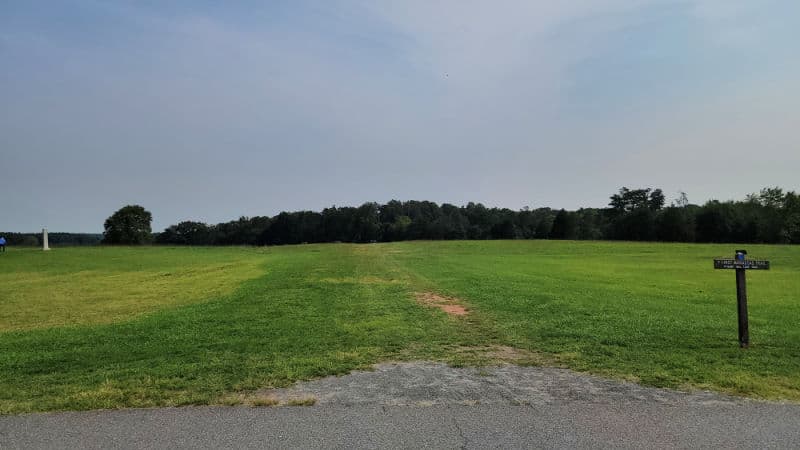
Details about Manassas National Battlefield Park
Size - 5,073 acres
Check out how Manassas NBP compares to other National Parks by Size.
Date Established
November 14, 1936 - Bull Run Recreational Demonstration Area established.
May 10, 1940 - Manassas National Battlefield Park Established
Visitation
In 2021, Manassas NBP had 516,604 park visitors.
In 2020, Manassas NBP had 558,036 park visitors.
In 2019, Manassas NBP had 510,427 park visitors.
Learn more about the most visited and least visited National Parks in the US
National Park Address
6511 Sudley Road, Manassas, VA 20109
National Park Map
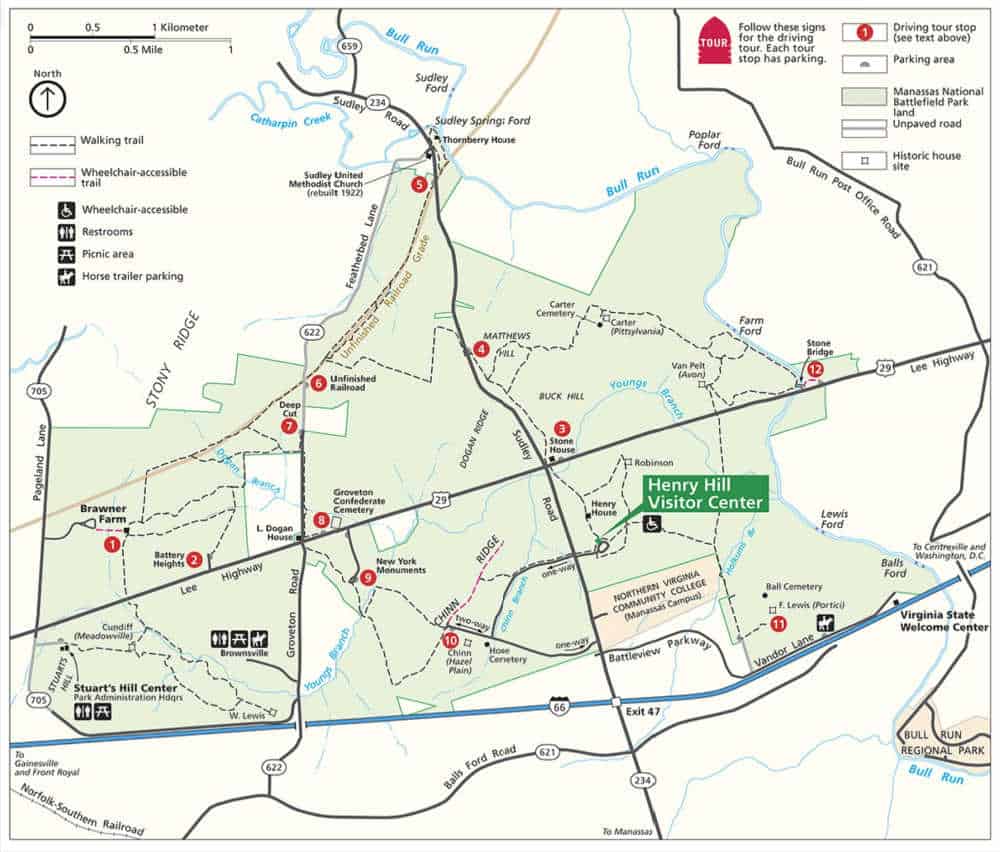
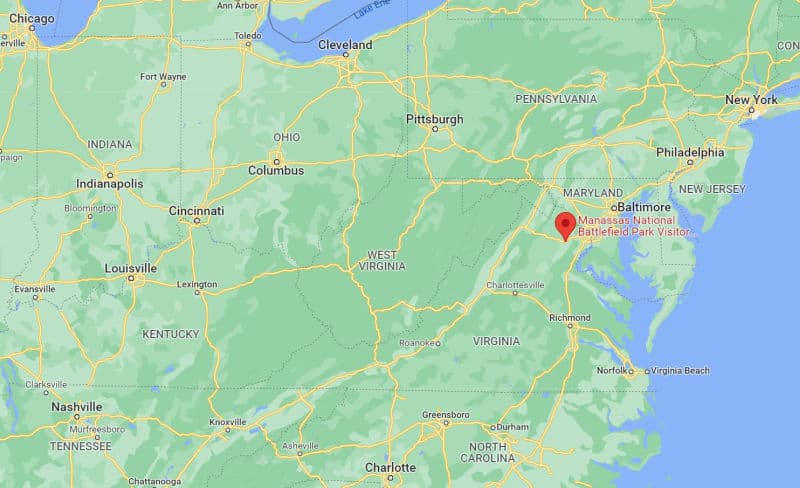
Where is Manassas National Battlefield Park?
Located right off Interstate 66, just 26 miles west of Washington D.C.
Estimated distance from major cities nearby
Washington DC - 28 miles
Baltimore, MD - 65 miles
Norfolk, VA - 189 miles
Philadelphia, PA - 167 miles
Chesapeake, VA - 200 miles
Virginia Beach, VA - 202 miles
Pittsburgh, PA - 247 miles
Durham, NC - 252 miles
Estimated Distance from nearby National Park
Shenandoah National Park - 39 miles
New River Gorge National Park - 273 miles
Great Smoky Mountains National Park - 451 miles
Congaree National Park - 478 miles
Mammoth Cave National Park - 613 miles
Where is the National Park Visitor Center?
Henry Hill Visitor Center is located right off of the Lee Highway and Sudley Road in the heart of the park.
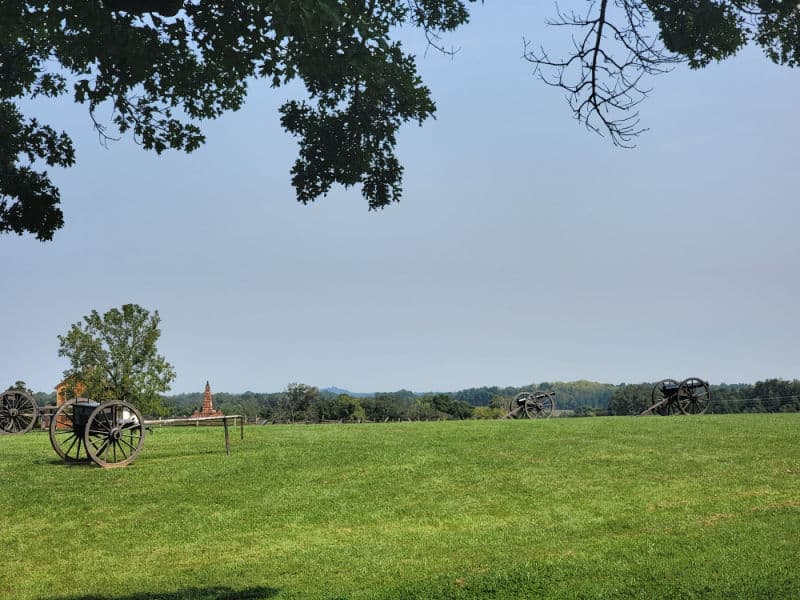
Getting to Manassas National Battlefield Park
Closest Airports
Washington Dulles International Airport (IAD)
Ronald Reagan Washington National Airport (DCA)
International Airports
Baltimore/Washington International Airport (BWI)
Richmond International Airport (RIC)
Regional Airports
Charlottesville Albermarle Airport (CHO)
Hagerstown Regional Airport (HGR)
Shenandoah Valley Regional Airport (SHD)
Driving Directions
From Washington D.C. and East
Travel west on I-66 to Exit 47B, Route 234 North (Sudley Road). Proceed through the first traffic light. The entrance to the Henry Hill Visitors Center is on the right, just past the Northern Virginia Community College.
From North
Travel south on I-95 to the Capital Beltway (Route 495). Travel west towards Silver Springs, MD.
Continue on the Beltway for approximately 10 miles, crossing the Potomac river into Virginia. Take the exit for I-66 west to Manassas.
Take Exit 47B, Route 234 North (Sudley Road). Proceed through the first traffic light. The entrance to the Henry Hill Visitors Center is on the right, just past the Northern Virginia Community College.
From South
Travel north on I-95 to Exit 152, Route 234. Turn left at the traffic light on to Route 234 North (Sudley Road). Stay on Business Route 234 (do not take the by-pass) and travel for approximately 20 miles just beyond the city of Manassas.
The entrance to the Henry Hill Visitors Center is located on the right, just past the entrance to the Northern Virginia Community College.
From West
Travel east on I-66 to Exit 47, Route 234 North (Sudley Road). Turn left on Route 234 and proceed through the first traffic light. The entrance to the Henry Hill Visitors Center is on the right, just past the Northern Virginia Community College.
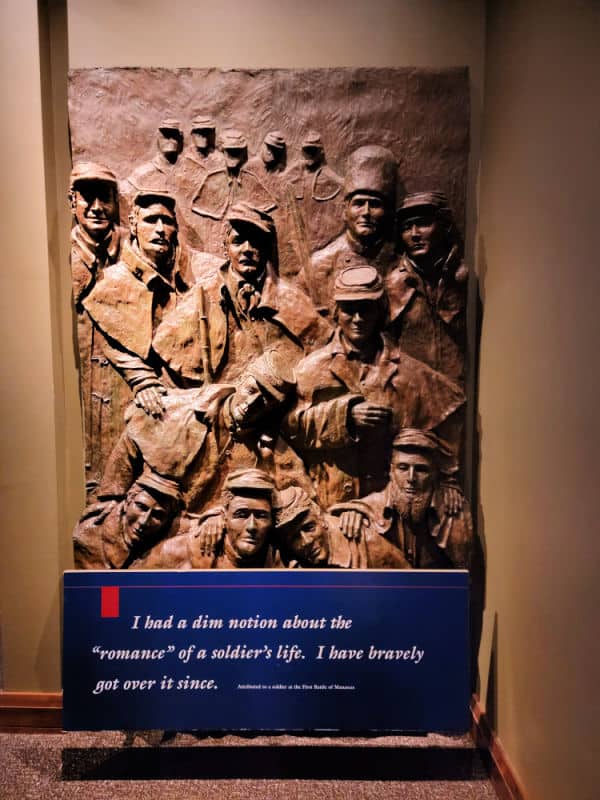
Best time to visit Manassas National Battlefield Park
The best time to visit the park is early summer and late summer to fall when the weather is not crazy hot and the mugginess is manageable.
Weather and Seasons
Manassas, Virginia experiences warm humid summers and cold snowy winters.
The hottest weather is from May 30 to September 16th with an average daily high above 78 degrees Fahrenheit.
The coldest weather is from December 1 to March 3rd with an average daily temperature below 51 degrees Fahrenheit.
May is the rainiest month in Manassas. Snow occurs on average from November 16th to March 27th with February getting the most snow.
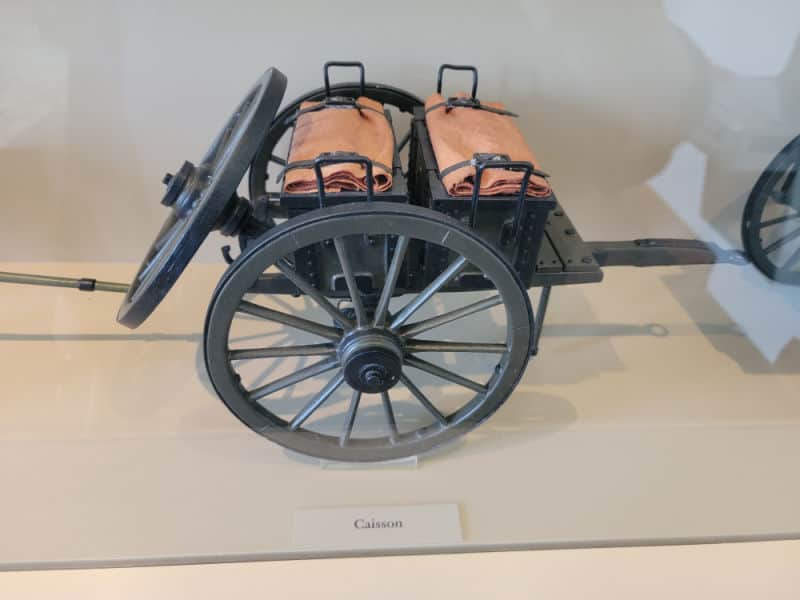
Best Things to do in Manassas National Battlefield Park
We suggest planning at least a minimum of a few hours to visit the park but you could easily spend a full day exploring.
Henry Hill Visitor Center
The Henry Hill Visitor Center has an information desk, museum exhibits, a fiber-optic battle map of First Manassas, an auditorium exhibiting the park orientation film, a bookstore, and public restrooms.
The park film "Manassas: End of Innocence" is a 45-minute film that covers both the First and Second Battles of Manassas. The film shows daily, every hour on the hour, starting at 9 a.m. with the last show at 4 p.m.
Open Daily, 8:30 a.m. to 5 p.m.
Closed Thanksgiving and December 25
Address: 6511 Sudley Road, Manassas, VA 20109
Brawner Farm Interpretive Center
The Brawner Farm Interpretive Center is located near the western entrance of the park, focuses on the events of the Second Battle of Manassas, and is a great starting point for park hiking trails in the western half of the park.
Restrooms are available in the parking lot.
Interpretive exhibits and rangers are in the Brawner House itself. Brawner Farm is open seasonally from mid-spring through late fall.
Junior Ranger Program
You can pick up a Junior Ranger Program at the Henry Hill Visitor Center.
You can also earn your Junior Ranger program by doing activities at home and emailing the park. Learn more about the program here.
Guided Ranger Tours
Check out the guided tours page to learn more about the ranger-led walks and tours of Manassas Battlefield. Tours are free and no advanced reservation is required.
Here are examples of the current tours being offered by the park. They are subject to change so make sure to check the park's tour page before heading to the park for a program.
First Manassas Programs
Henry Hill Walking Tour
Daily at 11 a.m. & 2 p.m.
Please meet at the Henry Hill Visitor Center.
Second Manassas Programs
Brawner Farm Walking Tour
Daily at 11:15 a.m., 1:15 p.m., & 3:15 p.m.
Please meet at the Brawner Farm Interpretive Center (Tour Stop #1).
Deep Cut Walking Tour
Daily at 1 p.m.
Please meet at the Deep Cut Parking Lot (Tour Stop #7).
Chinn Ridge Walking Tour
Daily at 3 p.m.
Please meet at Chinn Ridge (Tour Stop #10).
Self Guided Auto Tour
The self-guided auto tour includes 12 stops.
You can buy an interpretive CD at the park store to play in your car or download a free battlefield app for either the first or second battle, produced by the American Battlefield Trust.
Historic Weapons Demonstrations
Historic weapons demonstrations are offered on weekends and during the summer. Please check the posted schedule at the Visitors Center for a listing of times.
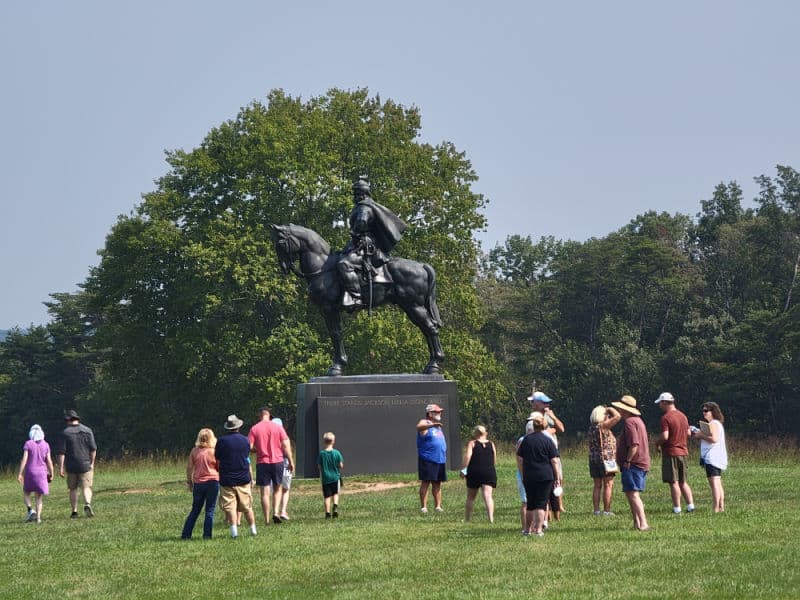
Hiking in Manassas National Battlefield Park
Always carry the 10 essentials for outdoor survival when exploring.
There are over 40 miles of trails in the park.
Download the park's Hiking Trail Map before your visit to help plan your trip.
Henry Hill Loop Trail
Distance - 1.1-mile circuit hike
Difficulty - Easy
Elevation Change - 120 feet
The Henry Hill Loop Trail starts behind the visitor center. There are markers and a mowed path that makes it easy to follow.
How to beat the crowds in Manassas National Battlefield Park?
The best way to beat the crowds is to visit during the week. Weekends are BUSY!
Where to stay when visiting Manassas National Battlefield Park
There are no National Park Lodges within the park.
There is lodging available within a few miles of the park including:
Hilton Garden Inn - You can look forward to a bar, a gym, and a restaurant at Hilton Garden Inn Manassas.
Hampton Inn - At Hampton Inn Manassas, you can look forward to a free breakfast buffet, dry cleaning/laundry services, and a 24-hour gym. In addition to a 24-hour business center, guests can connect to free in-room Wi-Fi.
Holiday Inn Express and Suites - You can look forward to free self-serve breakfast, dry cleaning/laundry services, and a fireplace in the lobby at Holiday Inn Express and Suites Manassas, an IHG Hotel. Free in-room Wi-Fi is available to all guests, along with a gym and a 24-hour business center.
Wyndham Garden - At Wyndham Garden Manassas, you can look forward to a free breakfast buffet, a terrace, and laundry facilities. Be sure to enjoy a meal at Applegates, the onsite family restaurant. Stay connected with free in-room Wi-Fi, and guests can find other amenities such as a bar and a 24-hour gym.
Courtyard by Marriott - Consider a stay at Courtyard by Marriott Manassas Battlefield Park and take advantage of a grocery/convenience store, a terrace, and a coffee shop/cafe. Free in-room WiFi is available to all guests, along with dry cleaning/laundry services and a 24-hour gym.
Click on the map below to see current rates at hotels and vacation rentals near the park.
Camping
There are no campgrounds within the park.

For a fun adventure check out Escape Campervans. These campervans have built in beds, kitchen area with refrigerators, and more. You can have them fully set up with kitchen supplies, bedding, and other fun extras. They are painted with epic designs you can't miss!
Escape Campervans has offices in Vancouver, Seattle, Portland, San Francisco, Las Vegas, Los Angeles, Phoenix, Salt Lake City, Denver, New York, and Orlando
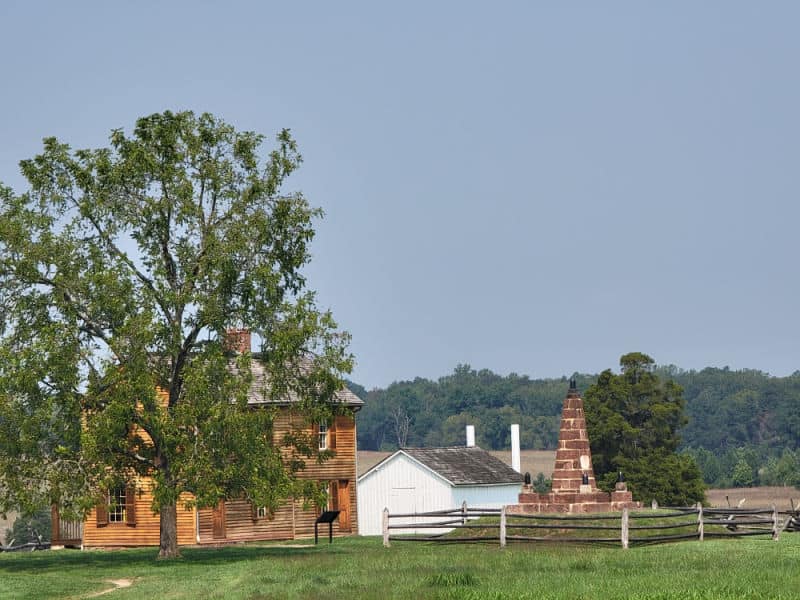
Additional Resources
The First Battle of Manassas: An End to Innocence, July 18-21, 1861
Manassas: A Battlefield Guide (This Hallowed Ground: Guides to Civil War Battlefields)
Return to Bull Run: The Campaign and Battle of Second Manassas
The Greatest Civil War Battles: The Second Battle of Bull Run (Second Manassas)
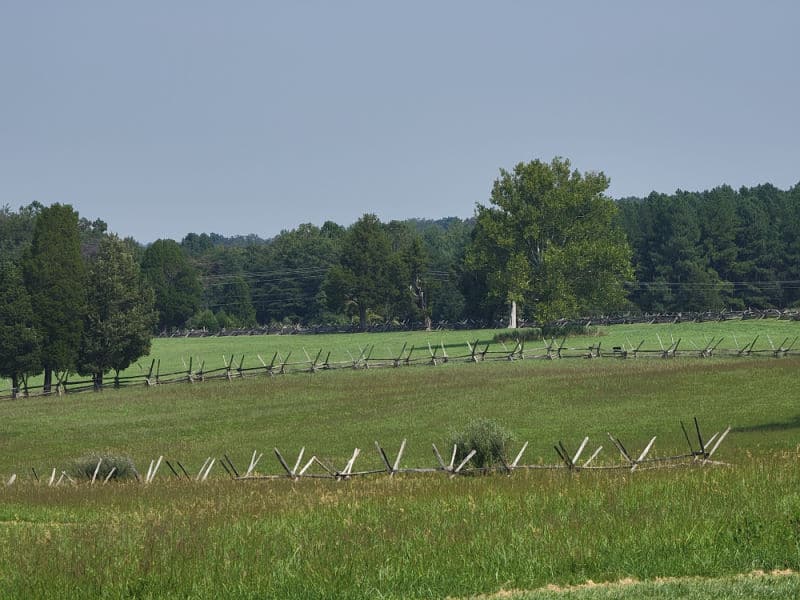
National Park Sites related to Manassas Battlefield
First Manassas Campaign Related Sites
Arlington House, The Robert E. Lee Memorial
Harpers Ferry National Historical Park
Second Manassas Campaign Related Sites
Antietam National Battlefield
Richmond National Battlefield Park
Parks sites near Manassas NBP
Fredericksburg & Spotsylvania National Military Park
Cedar Creek & Belle Grove National Historical Park
Prince William Forest Park
National Mall and Memorial Parks
Check out all of the Virginia National Parks along with neighboring National Parks in West Virginia, National Parks in Tennessee, North Carolina National Parks, Maryland National Parks, and Kentucky National Parks
Don't miss these epic things to do in Charlottesville, VA during your time visiting.
National Park Service Website - https://www.nps.gov/mana/
Make sure to follow Park Ranger John on Facebook, Instagram, Pinterest, and TikTok





Leave a Reply